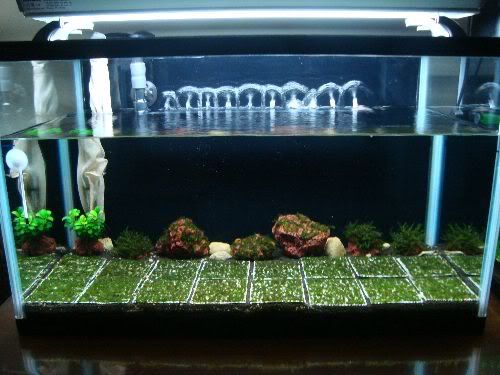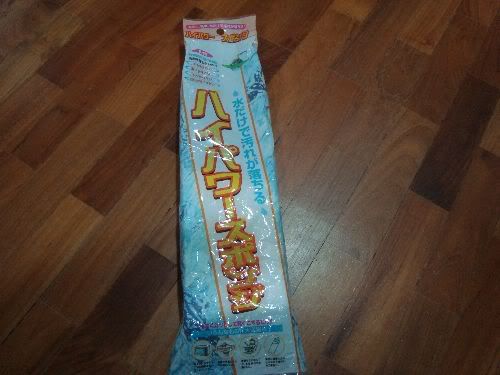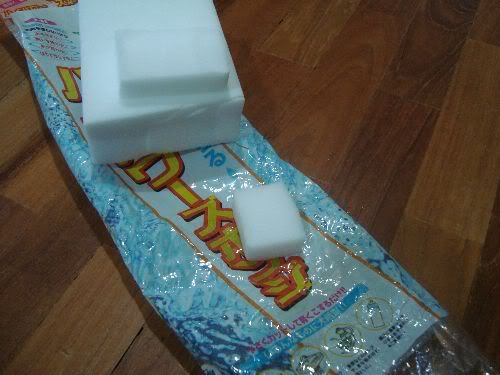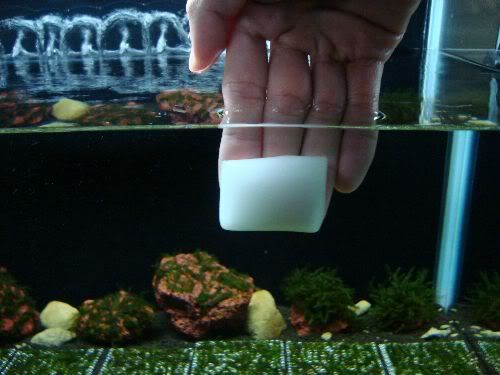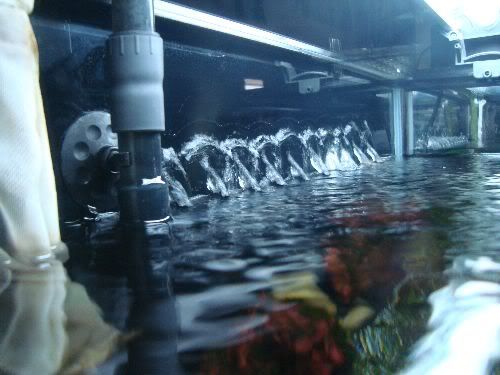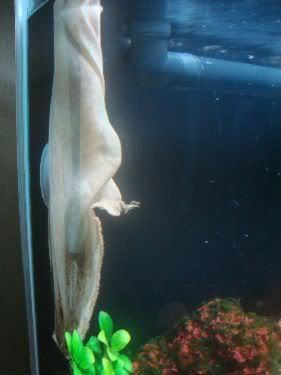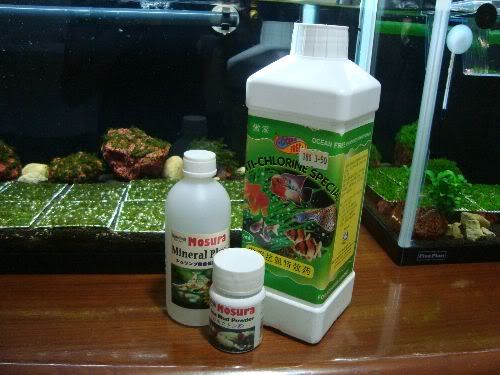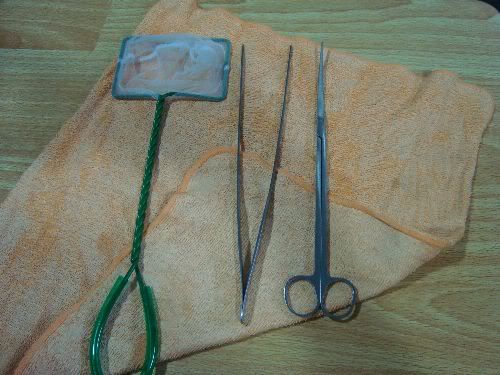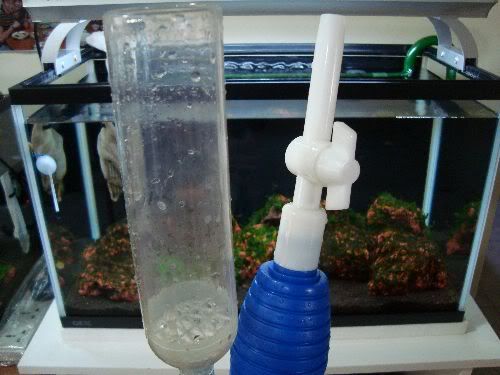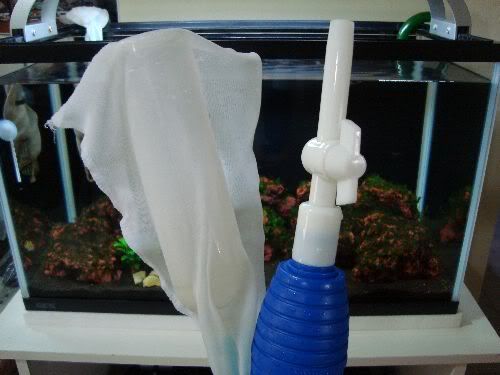We like to keep our shrimp tanks simple and neat. This helps with the maintenance of the tank as well as breeding (we will cover this in the "shrimp breeding tips" page) of the shrimps. Our breeding tanks are mostly bare or minimally planted with neatly tied moss as depicted in the picture below.
Clean and neat breeding tank. Picture shows rows of neatly tied fissidens onto stainless steel wire meshes. Of course this photo was taken when the tank was still new and plants have not yet matured.
This is why we keep the four sides of our breeding tank walls free and acessible. We will be able to see if there are any dirt build ups on the sides of the walls such as algae (there should be no algae problems if you follow the recommended light wattage as suggested in the "getting started" page) and or other parasites. Keeping the walls bare and accessible also allows us to clean the tank with ease and with no obstructions.
This is how we clean our tanks. Try to keep away from magnetic glass cleaners as much as possible as they might scratch the surface of your glass for one and they are alot harder to control, might even crush some tiny new born shrimplets if you're not careful with the magnetic glass cleaner. Instead, we use this material called the "power sponge". It is some japanese brand sponge which actually is a foam block or hard sponge which is used for cleaninig purposes. It comes in a package as such and with a big piece of foam block in it.
Japanese brand "power sponge". It can be found in most shops such as daiso or your local super market. Does not need to be the same brand. But check first to see that it has no added chemicals.
It comes packaged as a big block. Of course this one has already been used.
Cut a smaller piece from the big foam block. The size should be manageable for you to handle. Note that the small piece of foam can be reused over and again until you think that it has lost its shape and all you have to do is to cut out another piece.
This is how we clean the sides of our shrimp tank walls. It is very effective in cleaning out dirt as well as it gives you greater control of the area you want to clean. This way, you will never accidentally crush a poor shrimplet!
This is why we keep our tanks neat, simple and the sides clear of any obstructions. So that our hand can reach all sides. However, if you have found your own way of cleaning your tank and it works for you, by all means, continue with what you're comfortable with.
This next tip is a great one! Nothing fancy but it might just save you money and some electricity! If you are using a rainbar, this next tip applies to you.
We angle all our rainbar outlets upwards and out of the water as such.
We angle it as such because of several good reasons. Firstly, it helps to prevent stagnant spots of water as there is a constant water current and circulation at the water's surface. This prevents mosquitos from breeding and there won't be the "oily film" or "muck" that forms on the surface of the water. Secondly, it helps to circulate natural oxygen and carbon dioxide into the tank! You can see from the picture below that natural oxygen bubbles and carbon dioxide are being forced into the tank. You can remove your air pump totally and you don't have to spend money injecting CO2 into your tank. Assuming of course that the plants you use are low requirement plants which we will cover in the "Plants for your shrimp tank" page.
Picture on the left shows natural oxygen (good for shrimps) and natural carbon dioxide (good for plants) being created by the upward placement of the rainbar.
Always use a good and durable netting to cover your filter inlet. The holes must be fine enough to prevent tiny new born shrimplets from entering the filter inlet but also allowing water to flow through without obstruction. A netting such as the one shown in the picture can be purchased at most local fish shops for just a dollar or under.
Just be sure to keep it neat by tucking away the loose or extra netting. Also, fasten the top of the netting tightly with a cable tie to prevent the net from coming loose.
This next part is to do with what we add to our water during water top ups and water changes. We do water changes on average, every month. This is how we conduct our water changes. We DO NOT do water changes when there are many berried female shrimps as this will cause them to molt and maybe even drop their eggs. Instead, we do a water change once they have given birth after which a water change will induce molting and the females will almost always become berried again, with luck! However, we will discuss this issue more in the "shrimp breeding tips" page. Now... what do we add to our water?
Truth be told, this is all there is to it! A cheap ocean free anti-chlorine soultion, a couple of drops of mosura mineral plus and a pinch of old sea mud powder goes into a standard sized pail. Let the pail sit for about 45 minutes to an hour and you're ready to pour it into the tank. We do not add anything else! We have heard over and over again of hobbyists adding in too many different types of products in bid to increase the colouration and health of their shrimps and their shrimps end up dying!
We have used these simple products with no ill effects for the past 2 years of shrimp breeding and keeping.
But please stick to your regime if you have one working for you and your tank. This is only showing what and how we do it at Shrimps Online and it is by no means the best method or the only method.
These are also some tools which you should have which will come in handy when doing some maintenance in your shrimp tank.
A handy medium sized towel to keep the place dry or to clean the outside of your tank and equipment. A pair of stainless steel tweezers and a scissor. And a small net to help fish out left over food which is hard to pick out with a tweezer when they break apart as well as to catch out your shrimps =).
Some people have wrote in to ask how we siphon our water out of our shrimp tanks during water changes. Unlike fishes, shrimps are small enough to get sucked out by the siphon tube or other siphoning devices that you may have.
As such, it is important to ensure that this does not happen by adding a cheap and simple netting sleeve as shown in the pictures below. This netting sleeve can also be added to your filter intake to prevent tiny shrimplets from getting sucked in or out during a water change. All you have to do is slot the sleeve over the siphon and hold it in place while the water gets siphoned out.
This netting sleeve can be bought at your local fish shops for just under a dollar. The holes in this netting is big enough to let water pass through but not big enough for tiny shrimplets to get through.
Another good tip to note if you're working with electrical appliances nearby or with a multi plug or extension cord, is to wrap it with a piece of kitchen use clear cling wrap as shown in the picture. Water should not be splashed onto any electrical devices at all but just in case if it does, at least the cling wrap gives some protection.
Just be sure to tuck the cling wrap so that it is snug and neat.
We hope that you have enjoyed the tips that we have provided and please do give us feedback if there are other tips that you would wish to see on this website.
Thank you.
Shrimps Online team.
